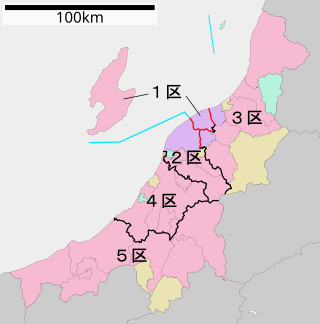
Niigata currently sends 12 elected members to the Diet of Japan, 10 to the House of Representatives and 2 to the House of Councillors. The prefecture lost 1 Councillor due to reapportionment in 2019.

Niigata currently sends 12 elected members to the Diet of Japan, 10 to the House of Representatives and 2 to the House of Councillors. The prefecture lost 1 Councillor due to reapportionment in 2019.
The current House of Representatives Niigata delegation consists of 6 members of the LDP, 3 members of the CDP and 1 independent politician.
| District | Representative | Party | Incumbency |
|---|---|---|---|
| 1st |  Chinami Nishimura | Constitutional Democratic | 22 October 2017 – present |
| 2nd |  Kenichi Hosoda | Liberal Democratic | 31 October 2021 – present |
| 3rd |  Hiroaki Saito | Liberal Democratic | 31 October 2021 – present |
| 4th |  Makiko Kikuta Makiko Kikuta | Constitutional Democratic | 22 October 2017 – present |
| 5th |  Ryuichi Yoneyama | Constitutional Democratic | 31 October 2021 – present |
| 6th | Mamoru Umetani | Constitutional Democratic | 31 October 2021 – present |
| Representative | Party | District contested | Incumbency |
|---|---|---|---|
| Shūichi Takatori (LD-Jōetsu) | LDP | Niigata-6th | 26 December 2012 – present |
| Ichirō Tsukada (LD-Niigata City) | Niigata-3rd | 24 December 2014 – present | |
| Hirohiko Izumida (LD-Nagaoka) | Niigata-5th | 1 November 2017 – present | |
| Isato Kunisada (LD-Sanjō) | Niigata-4th | 3 November 2021 – present | |
The current House of Councillors Niigata delegation consists of 1 member of the CDP and 1 member of the LDP. The members are elected from the Niigata at-large district.
| Party | Councillors | Term ends | Incumbency |
|---|---|---|---|
| LDP | Kazuhiro Kobayashi | 2028 | 26 July 2022 – present |
| CDP | Sakura Uchikoshi | 2025 | 29 July 2019 – present |

Politics of Japan are conducted in a framework of a dominant-party bicameral parliamentary constitutional monarchy, in which the Emperor is the head of state and the Prime Minister is the head of government and the head of the Cabinet, which directs the executive branch.

The National Diet is the national legislature of Japan. It is composed of a lower house, called the House of Representatives, and an upper house, the House of Councillors. Both houses are directly elected under a parallel voting system. In addition to passing laws, the Diet is formally responsible for nominating the Prime Minister. The Diet was first established as the Imperial Diet in 1890 under the Meiji Constitution, and took its current form in 1947 upon the adoption of the post-war constitution. Both houses meet in the National Diet Building in Nagatachō, Chiyoda, Tokyo.

The House of Representatives is the lower house of the National Diet of Japan. The House of Councillors is the upper house. The composition of the House is established by Article 41 and Article 42 of the Constitution of Japan. The House of Representatives has 465 members, elected for a four-year term. Of these, 176 members are elected from 11 multi-member constituencies by a party-list system of proportional representation, and 289 are elected from single-member constituencies.

The House of Councillors is the upper house of the National Diet of Japan. The House of Representatives is the lower house. The House of Councillors is the successor to the pre-war House of Peers. If the two houses disagree on matters of the budget, treaties, or the nomination of the prime minister, the House of Representatives can insist on its decision. In other decisions, the House of Representatives can override a vote of the House of Councillors only by a two-thirds majority of members present.

The Japanese political process has two types of elections.

House of Councillors elections were held in Japan on 22 June 1980. On 16 May the Japan Socialist Party (JSP) brought no-confidence motion before the Diet relating to corruption issues, proposing more defense spending and rises in public utility charges as reasons for the House of Representatives to withdraw its backing from the government. Unexpectedly, 69 Liberal Democratic Party (LDP) members of the Diet from the Fukuda Takeo, Miki Takeo and Hidenao Nakagawa factions abstained from voting on the motion. The government was defeated by 56 votes in total of 243 and resigned. For the first time elections for both the House of Councillors and the House of Representatives were elected at the same time. In the elections of both the houses the LDP gained a majority.

House of Councillors elections were held in Japan on July 11, 2010. In the previous elections in 2007 the Liberal Democratic Party (LDP) had lost its majority to the Democratic Party (DPJ), which managed to gain the largest margin since its formation in 1996. The House of Councillors is elected by halves to six-year terms. The seats up for election in 2010 were last contested in the 2004 election.

Niigata 5th district is a single-member electoral district for the House of Representatives, the lower house of the National Diet of Japan. It is located in the central, Chūetsu region of Niigata and covers parts of Nagaoka City, the cities of Ojiya, Uonuma, Minami-Uonuma as well as the former Minami-Uonuma County that, as of 2012, only has one remaining municipality: Yuzawa Town. As of September 2012, 282,904 voters were registered in Niigata 5th district, giving its voters above average vote weight.

General elections were held in Japan on 22 October 2017. Voting took place in all Representatives constituencies of Japan – 289 single-member districts and eleven proportional blocks – in order to appoint all 465 members of the House of Representatives, the lower house of the then 707-member bicameral National Diet of Japan. Incumbent Prime Minister Shinzō Abe's governing coalition of the Liberal Democratic Party (LDP) and the Komeito party retained their seats in signs of what was perceived as weak opposition. The PM won his fourth term in office and held on to the two-thirds supermajority in order to implement policies on revising the war-renouncing Article 9 of the Japanese Constitution.

The Hyogo at-large district is a constituency that represents Hyogo Prefecture in the House of Councillors in the Diet of Japan. It currently has five Councillors in the 242-member house, but this representation will increase to six by July 2019.
The Democratic Party, abbreviated as DP, was a political party in Japan. It was the largest opposition political party in Japan from 2016 until its marginalization in the House of Representatives in 2017. The party was founded on 27 March 2016 from the merger of the Democratic Party of Japan and the Japan Innovation Party. The majority of the party split on 28 September 2017, before the 2017 general election. Many of its members contesting the election as candidates for the Party of Hope, Constitutional Democratic Party of Japan or as party members without nomination. On 7 May 2018 the DP merged with the Party of Hope to form the Democratic Party For the People.

The Niigata at-large district is a constituency that represents Niigata Prefecture in the House of Councillors in the Diet of Japan. Since July 2019, it has two Councillors in the 242-member house, a decrease from its previous contingent of 3. Similar to other rural two seat districts in Northern Japan such as the Iwate at-large district, it often shows a willingness to buck the LDP and instead vote for opposition backed candidates, such as in 2019. Nonetheless, the LDP won the district by six points in the 2022 elections, and Uchikoshi only won by a margin of four points.

Niigata 1st district is a constituency of the House of Representatives in the National Diet of Japan, represented by Chinami Nishimura of the Constitutional Democratic Party of Japan since 2017. As of 2017, 439,968 eligible voters were registered in the district

Hokkaido currently sends 26 elected members to the Diet of Japan, 20 to the House of Representatives and 6 to the House of Councillors. The prefecture sends 6 Councillors after the 2019.

Okinawa currently sends 8 elected members to the Diet of Japan, 6 to the House of Representatives and 2 to the House of Councillors.

Tokyo currently sends 53 elected members to the Diet of Japan, 42 to the House of Representatives and 11 to the House of Councillors.

Aichi Prefecture currently sends 34 elected members to the Diet of Japan, 26 to the House of Representatives and 8 to the House of Councillors.
The 2018 Niigata gubernatorial election was held on 10 June 2018 to elect the next governor of Niigata. Incumbent Governor Ryuichi Yoneyama resigned on 18 April 2018 in the wake of a sex scandal. This was also the first gubernatorial election in Niigata since the voting age was lowered to 18.